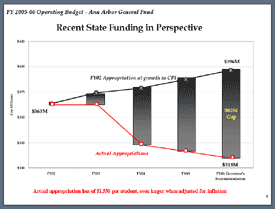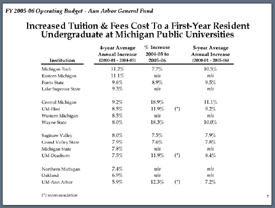|
|
Saying the University is at a crossroads with respect to declining state funding, U-M President Mary Sue Coleman delivered to the Board of Regents today (July 21) a budget that relies to a significant extent on increasing tuition.
“Last year we had three strikes against us on the funding front: another reduction in our state appropriation, artificially restrained tuition and then an unexpected midyear cut,” Coleman said. “At that time I said such a combination couldn’t continue without jeopardizing the ability of this University to provide a high-quality education.
 |
| Click image to enlarge in new window |
“The unprecedented loss of state appropriations over the past several years now threatens to compromise the University of Michigan’s core academic excellence. As we look ahead to the fourth year of likely cuts in state support, it is clear we are at a crossroads which will define Michigan’s future strength.”
In FY2002 the state’s appropriation to the Ann Arbor campus was about $363 million; under the governor’s proposed budget that figure would decline to $314 million for FY2006. That $49 million decline amounts to a decrease of more than $1,500 per student at the Ann Arbor campus, and has been coupled with nearly $21 million in one-time cuts.
Provost Paul N. Courant noted that if the state’s funding support over the four-year period had simply kept pace with inflation as measured by the Consumer Price Index, the University’s appropriation for FY2006 would be $396 million, an $82 million gap which the University has managed largely by making cuts in expenditures.
“The accumulated effects of these budget cuts are enormous,” Coleman said. “We cannot hope to make it through another year of low salary increases and minimal investment in our academic programs without resulting damage to our core business. I am particularly concerned about the threat to faculty and staff recruitment and retention as we compete with the best universities in the country. Also, we must continue to provide the services students need, address pressing issues such as manageable class size and course availability, and make investments in curriculum renewal as well as innovative new programming.
“Our students, alumni, donors and state invest in U-M and share our expectation that Michigan will continue to remain at the forefront of academic and research excellence,” she added. “My most important obligation as president is to ensure that quality continues to be the number-one return on our stakeholders’ investment.”
 |
|
Click image to enlarge in new window
|
The budget approved by Regents includes a 12.3 percent tuition increase for resident undergraduates, and a 6 percent increase for undergraduates from out of state. At the same time, the University plans to increase centrally budgeted financial aid in the General Fund by 14.5 percent for resident undergraduates and 6.3 percent for nonresidents. The M-PACT program launched by the University in February adds to the General Fund amount, meaning that U-M’s new commitments to financial aid will result in an overall increase in grant aid for resident undergraduate students of 28.6 percent.
Under the proposed budget, a first-year Michigan resident student entering the College of Literature, Science and the Arts would pay $9,213 per year for tuition and all required fees, an increase of $1,012, while a nonresident student would pay $27,601, an increase of $1,574—before calculating financial aid support.
Despite this year’s increase, the U-M’s average tuition increase during the past five years is lower than all public universities in the Big Ten and close to the lowest in the state.
“We worked hard to restrain our tuition increases over the past few years in the hopes that the state funding picture would improve,” Courant said. “Those improvements haven’t materialized, and instead we have sunk into one of the worst consecutive four-year periods for state support in our history. Now we have to catch up, in contrast to many of our peer institutions who have sought greater tuition increases in the past or have seen state support recover, or both.”
Coleman and Courant said the decision to recommend significant tuition increases was not an easy one, particularly in light of concerns that a U-M education should remain affordable for students of modest means. “This University has consistently placed financial aid at the top of our priority list,” Courant said. “In this budget, as in past years, we have increased financial aid at a rate greater than the increase in tuition, so that our most vulnerable students will not suffer an undue burden.
“Our financial aid packages will continue to ensure that all Michigan resident undergraduates will receive a combination of grants, loans and work-study awards that cover their full financial need, including not only tuition but also room and board, books and related expenses.”
The University will allocate nearly $85 million in its General Fund to centrally budgeted financial aid for FY2006. M-PACT will provide an additional $3 million per year in grant assistance to low- and moderate-income students who are Michigan residents. As a result of these programs, the lowest-income in-state students—those who receive a full Pell grant—will receive total grant assistance of more than $13,000 per year. M-PACT grants also will go to Michigan resident students whose families earn a bit more—typically in the range of $50,000 to $70,000. Raising money for financial aid for both in-state and out-of-state students is a major goal of the University’s current fundraising campaign, The Michigan Difference.
The total General Fund budget for the Ann Arbor campus—with revenues comprised primarily of state appropriations, tuition and indirect cost recovery on sponsored research—will increase 4.9 percent from FY05 to FY06. The budget allocates the majority of new funds to the academic units, with smaller increases to administrative units.
“Once again, as in recent years, we expect to enroll a record number of students and conduct a greater amount of research than ever before,” Courant said. “As our teaching and research continue to grow, these activities bring with them corresponding costs. It is essential that we find ways to support this growth if we are to help the state achieve its goals of increasing college attainment and developing the research discoveries that contribute to a robust economy and improved quality of life for all our citizens.”
The Ann Arbor campus enrolled a record freshman class last year of 6,040, and expects another large incoming class this fall. Total undergraduate enrollment also set a record in 2004. The University brought $536 million in federal research funds into the state of Michigan in 2004.


